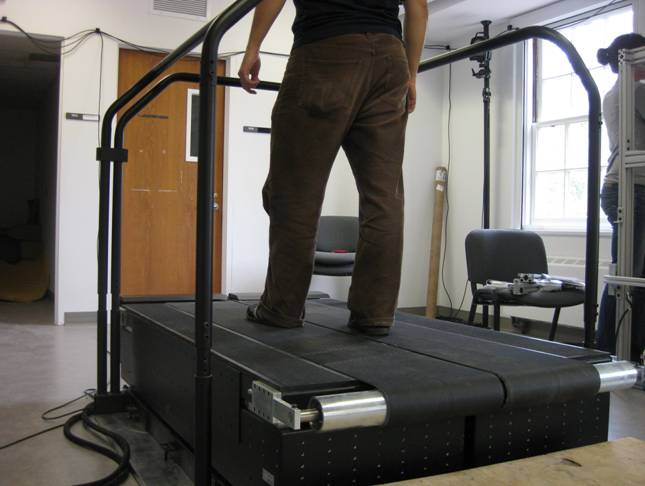Virtual Environments for Rehabilitation of Patients with Asymmetric Gait

Gait asymmetry is a common consequence of stroke, traumatic brain injury, and spinal cord injury. The work of this collaboration focuses on patients with stroke, but the results will be applicable to other populations. The Bertec dual-belted treadmill shown in the picture is instrumented with force sensors under each belt. The capabilities of this device, and the availability of CISMM expertise in virtual locomotion and control devices offers a unique opportunity to investigate rehabilitation protocols for locomotion enhanced with virtual environment technologies.
The cause of many walking abnormalities arises from the patient’s physical interaction with the environment (i.e., ground reaction forces). Walking speed , which is often cited as the greatest locomotor deficit, is directly influenced by the amount of push-off or propulsion provided by the feet on the ground (Bowden 2006; Turns 2007). An inability of the affected, or paretic, side to generate an adequate propulsive force leaves limb movements asymmetrical (Reisman 2007). Current approaches to improving gait speed and restoring gait symmetry do not provide essential feedback of impaired ground reaction forces. We propose that the use of appropriate force feedback control, displayed both visually using a virtual environment (VE) and from proprioceptive inputs, through altered limb movements, will improve locomotor training by enhancing ground reaction forces.
The use of virtual environments represents a safe, motivating medium for rehabilitation. Novel movement tasks can be learned within a VE (Chua 2003) as the ability to modify the environment may encourage the adaptation of beneficial movements. In particular, the use of VEs can be used to introduce physical (barriers, walls), temporal (speed requirements), and cognitive (attention, planning) challenges to locomotion (Fung 2006). Furthermore, a VE can provide post-stroke patients with enhanced feedback in the form of knowledge of both results and performance, which can enhance motor skills (Winstein 1999). As an intense, goal-directed medium, VEs attract patients’ attention and challenge them to complete physical tasks, all of which are critical elements for eliciting behavioral changes in locomotor performance.
Smooth treadmill-VE coupling and control by the user are imperative for successful immersion of the user for locomotor training. Previous applications have provided exploration of the VE by patients post-stroke using either joystick control (Brooks 2004) or feedback from the subject’s position relative to a treadmill (Fung 2006). Coupling the VE to treadmill walking represented a significant advancement in the rehabilitation of individuals with CNS damage. Users are able to practice walking while controlling the speed of the treadmill, and thus the VE, via feedback of their anterior/posterior position relative to the treadmill. The work of this collaboration will extend the use of ground reaction forces to control of locomotion direction, leaving the user’s hands and arms free so they can be used in a natural fashion to help the user stay balanced.
The use of a split-belt instrumented treadmill to control gait speed and the VE using GRF data can improve rehabilitation post-stroke. Our proposed approach of using ground reaction force data for VE and treadmill control leaves the subject unencumbered, allows for steering within the VE, and allows for independent measurements of each leg. Plus, feedback related to force production, a significant factor in gait speed, can be achieved visually with the VE, and peripherally through proprioceptive feedback from limb motion. Locomotor retraining is thought to need the correct sensory signals to converge in the CNS for appropriate learning. Our proposed approach allows us to take advantage of previously established factors considered essential for the restoration of locomotor ability (e.g., repeated stepping, body weight support). Providing subjects with appropriate optic flow during treadmill training and allowing control of the environment will enhance training by providing feedback regarding GRF applications.
Collaborators:
Michael Lewek, PT, PhD, Assistant Professor, Department of Allied Health Sciences (Div of Physical Therapy), University of North Carolina at Chapel Hill
Richard Segal, PT, PhD, Professor, Department of Allied Health Sciences (Div of Physical Therapy), University of North Carolina at Chapel Hill
Funding: North Carolina Biotechnology Center, Institutional Development Grant “Interdisciplinary Fundamental Studies of Mechanisms Underlying Human Movement” (PI: R Segal)
Funds from Division of Physical Therapy (Lewek’s start-up funding)